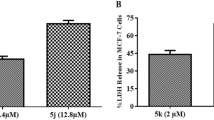Abstract
Dithiocarbamates (DTCs) exhibit a broad spectrum of antitumor activities, however, their molecular mechanisms of antitumor have not yet been elucidated. Previously, we have synthesized a series of novel dithiocarbamate derivatives. These DTCs were examined for cytotoxic activities against five human cancer cell lines. In this study, one of dithiocarbamate (DTC1) with higher potential for HeLa cells was chosen to investigate molecular mechanisms for its anti-tumor activities. DTC1 could inhibit proliferation, and highly induce apoptosis in HeLa cells by activating caspase-3, -6 and -9; moreover, activities of caspase-3, -6 and -9 were inhibited by pan-caspase inhibitor, Z-VAD-FMK. Furthermore, DTC1 decreased the levels of Bcl-2 and Bcl-xL, and increased expression of cytosol cytochrome c, Bak, Bax and p53 in a time-dependent manner but had no effect on the level of Rb. It was shown that DTC1 induced HeLa cells apoptosis through a p53-dependent pathway as tested by the wild type p53 inhibitor, pifithrin-α. Additionally, the relative expression of E6 and E7 were evaluated in HPV18-positive (HeLa cells) by real-time PCR and western blotting. The results firstly demonstrated that DTC1 suppressed both expression of E6 mRNA and E6 oncoprotein, but had no effect on the expression of E7 mRNA and protein in HPV18. Our results suggested that DTC1 may serve as novel chemotherapeutic agents in the treatment of cervical cancer and potential anti-HPV virus candidates that merit further studies.








Similar content being viewed by others
Abbreviations
- IC50 :
-
Half maximal inhibitory concentration
- PI:
-
Propidium iodide
- TLC:
-
Thin layer chromatography
- DMSO:
-
Dimethyl sulfoxide
- NMR:
-
Nuclear magnetic resonance
- PBS:
-
Phosphate-buffered saline
- BCA:
-
Bicinchoninic acid
- SDS-PAGE:
-
Sodium dodecyl sulfate poly-acrylamide gel electrophoresis
- DMEM:
-
Dulbecco’s modified Eagle’s medium
- FBS:
-
Fetal bovine serum
- MTT:
-
3-(4,5-Dimethylthiazol-2-yl)-2,5-diphenyltetrazolium bromide
- Caspase:
-
Cysteine-aspartic proteases or cysteine-dependent aspartate-directed proteases
- PMSF:
-
Phenylmethylsufonyl fluoride
- PVDF:
-
Poly-vinylidene difluoride
- Rb:
-
Retinoblastoma
- HPV:
-
Human papillomavirus
References
Orrenius S, Nobel CSI, van den Dobbelsteen DJ, Burkitt MJ, Slater AFG (1996) Dithiocarbamates and the redox regulation of cell death. Biochem Soc Trans 24:1032–1038
Nobel CSI, Burgess DH, Zhivotovsky B, Burkitt MJ, Orrenius S, Slater AF (1997) Mechanism of dithiocarbamate inhibition of apoptosis: thiol oxidation by dithiocarbamate disulfides directly inhibits processing of the caspase-3 proenzyme. Chem Res Toxicol 10:636–643
Xu LZ, Jiao K, Zhang SS, Kuang SP (2002) Studies on synthesis and biological activities of novel triazole compounds containing N, N-dialkyldithiocarbamate. Bull Korean Chem Soc 23:1699–1701
Ozkirimli S, Apak TI, Kiraz M, Yegenoglu Y (2005) Synthesis of new triazolyl-N, N-dialkyldithiocarbamates as antifungal agents. Arch Pharm Res 28:1213–1218
Imamura H, Ohtake N, Jona H, Shimizu A, Moriya M, Sato H, Sugimoto Y, Ikeyra C, Kiyonaga H, Nakano M, Nagano R, Abe A, Yamada K, Hashizume T, Morishima H (2001) Dicationic dithiocarbamate carbapenems with anti-MRSA activity. Bioorgan Med Chem 9:1571–1578
Reisinger EC, Kern P, Ernst M, Bock P, Flad HD, Dietrich M (1990) Inhibition of HIV progression by dithiocarb. German DTC Study Group. Lancet 335:679–682
Gaspari P, Banerjee T, Malachowski WP, Muller AJ, Prendergast GC, DuHadaway J, Bennett S, Donovan AM (2006) Structure-activity study of brassinin derivatives as indoleamine 2, 3-dioxygenase inhibitors. J Med Chem 49:684–692
Cao SL, Feng YP, Jiang YY, Liu SY, Ding GY, Li RT (2005) Synthesis and in vitro antitumor activity of 4 (3H)-quinazolinone derivatives with dithiocarbamate side chains. Bioorg Med Chem Lett 15:1915–1917
Elmore S (2007) Apoptosis: a review of programmed cell death. Toxicol Pathol 35:495–516
Prasad S, Soldatenkov VA, Srinivasarao G, Dritschilo A (1999) Intermediate filament proteins during carcinogenesis and apoptosis (Review). Int J Oncol 14:563–633
Fan TJ, Han LH, Cong RS, Liang J (2005) Caspase family proteases and apoptosis. Acta Bioch Bioph Sin 37:719–727
Xu G, Shi Y (2007) Apoptosis signaling pathways and lymphocyte homeostasis. Cell Res 17:759–771
Breckenridge DG, Xue D (2004) Regulation of mitochondrial membrane permeabilization by BCL-2 family proteins and caspases. Curr Opin Cell Biol 16:647–652
Hockenbery DM, Oltvai ZN, Yin XM, Milliman CL, Korsmeyer SJ (1993) Bcl-2 functions in an antioxidant pathway to prevent apoptosis. Cell 75:241–251
Gross A, McDonnell JM, Korsmeyer SJ (1999) BCL-2 family members and the mitochondria in apoptosis. Gene Dev 13:1899–1911
Yin Y, Solomon G, Deng C, Barrett JC (1999) Differential regulation of p21 by p53 and Rb in cellular response to oxidative stress. Mol Carcinog 24:15–24
Amaral JD, Xavier JM, Steer CJ, Rodrigues CM (2010) The role of p53 in apoptosis. Discov Med 9:145–152
Ola MS, Nawaz M, Ahsan H (2011) Role of Bcl-2 family proteins and caspases in the regulation of apoptosis. Mol Cell Biochem 351:41–58
Schiffman M, Castle PE, Jeronimo J, Rodriguez AC, Wacholder S (2007) Human papillomavirus and cervical cancer. Lancet 370:890–907
Moody CA, Laimins LA (2010) Human papillomavirus oncoproteins: pathways to transformation. Nat Rev Cancer 10:550–560
Kim YT, Zhao M (2005) Aberrant cell cycle regulation in cervical carcinoma. Yonsei Med J 46:597–613
Howie HL, Katzenellenbogen RA, Galloway DA (2009) Papillomavirus E6 proteins. Virology 384:324–334
Acknowledgments
This research was financially supported by Natural Science Foundation of Xinjiang Uygur Autonomous Region (No. 2011211B51) and Western Action Project of Bureau of Resources and Environmental Science, Chinese Academy of Sciences (KZCX-XB2-17), P. R. China.
Conflict of interest
The authors indicated no potential conflicts of interest.
Compliance with ethical standards
This research does not involve human participants and/or animals.
Author information
Authors and Affiliations
Corresponding author
Additional information
Yanhong Li and Hongxue Qi have contributed equally to this work.
Rights and permissions
About this article
Cite this article
Li, Y., Qi, H., Li, X. et al. A novel dithiocarbamate derivative induces cell apoptosis through p53-dependent intrinsic pathway and suppresses the expression of the E6 oncogene of human papillomavirus 18 in HeLa cells. Apoptosis 20, 787–795 (2015). https://doi.org/10.1007/s10495-015-1114-4
Published:
Issue Date:
DOI: https://doi.org/10.1007/s10495-015-1114-4




